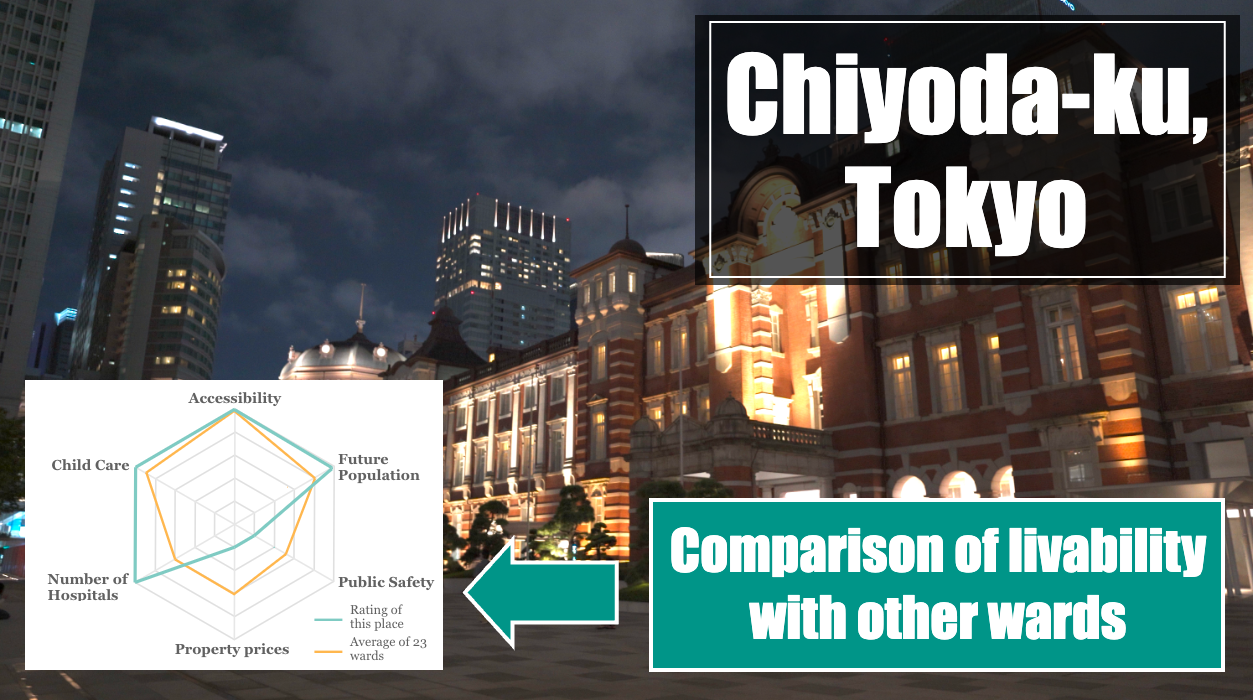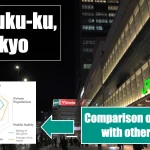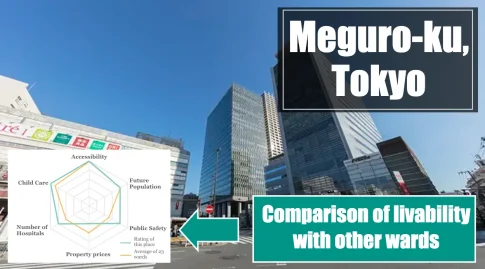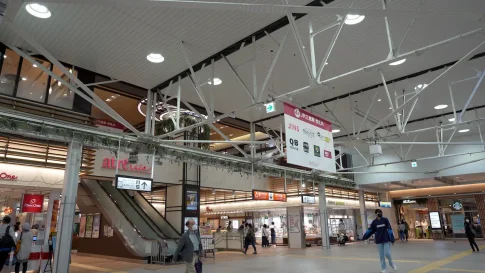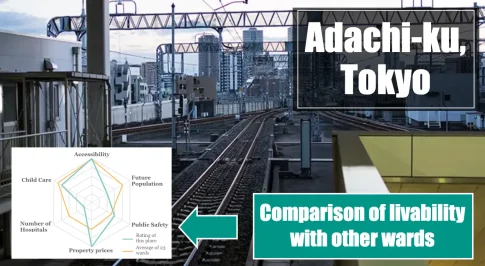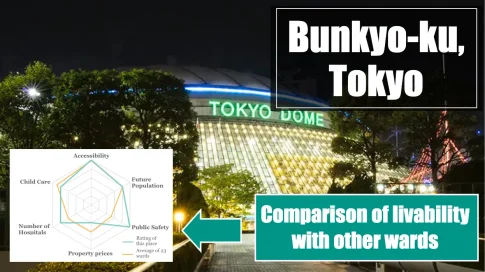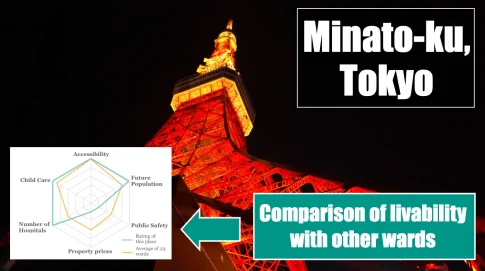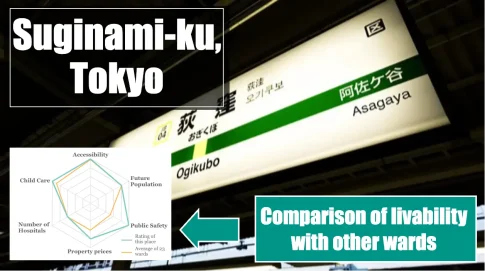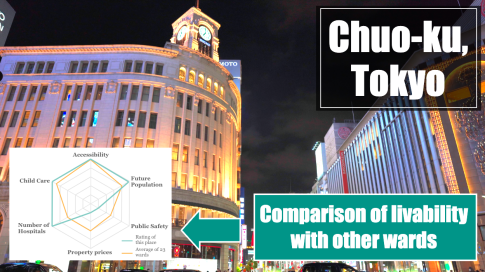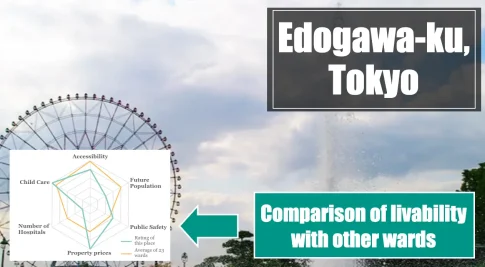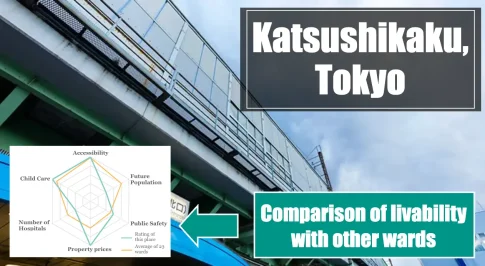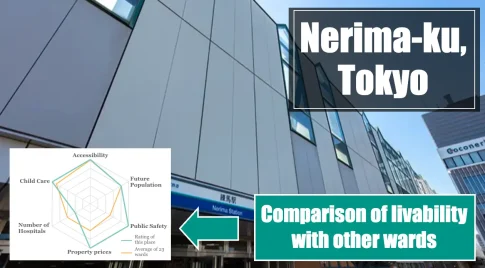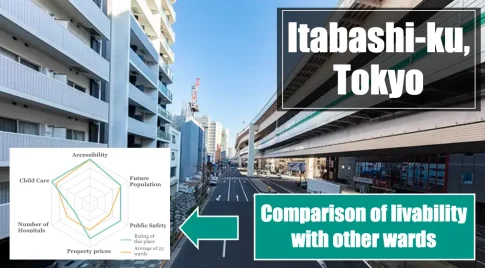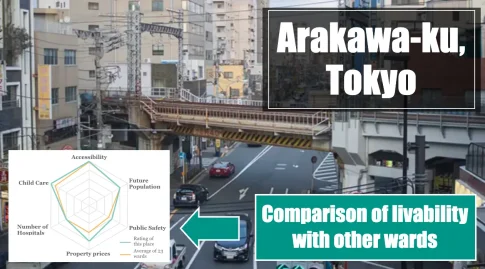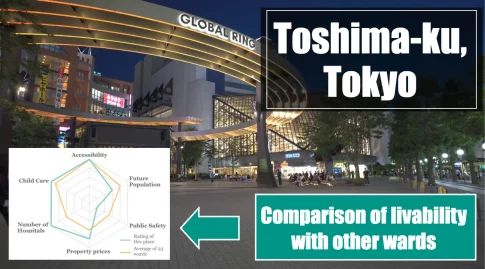This section introduces the livability of Chiyoda-ku, Tokyo compared to the other 23 wards.
Contents
Livability of Chiyoda-ku|First Conclusion
- Number of hospitals
- No. of children on waiting list 0
- Not safe in Tokyo
- High property prices
Chiyoda-ku is located in the center of Tokyo and is the political, economic, and cultural center of Japan. Chiyoda Ward has the following characteristics.
- The Imperial Palace is located in the district and occupies about 12% of the total area of the ward. The East Gardens of the Imperial Palace and Kitanomaru Park are open to the public, where visitors can enjoy historical buildings and beautiful nature.
- The three main centers of power and administration in Japan are concentrated in this area, including the National Diet Building, the Prime Minister’s official residence, the Supreme Court, and various central government ministries and agencies. Kasumigaseki and Nagatacho are known as synonymous with politics and bureaucracy.
- Marunouchi and Otemachi, centered around Tokyo Station, are Japan’s largest office districts. In recent years, Marunouchi has become an area with a variety of commercial facilities and hotels, making it an area not only for business, but also for shopping and dining.
- Kanda and Akihabara are areas where one can feel the atmosphere of a traditional downtown area, where the culture of the townspeople has remained since the Edo period. Kanda is famous as a town of learning and publishing, and is home to the Kanda Myojin Shrine and the Kanda Antique Bookstore District. Akihabara developed as an electronics town and is now known worldwide as a mecca for otaku culture.

To give you a brief idea of the livability of Chiyoda-ku, Tokyo, with these characteristics, it is a city with high accessibility, zero waiting children, and a large number of hospitals. However, it is not a safe place to live, and property prices are high.
The following is a detailed introduction with specific figures, so please read it through to the end.
Compare Chiyoda-ku with other wards

▼Accessibility
Calculated by the time it takes to get out to the Yamanote Line station.
5 = within 15 minutes
4 = within 20 minutes
3 = within 25 minutes
2 = within 30 minutes
1=more than 30 minutes
▼ Future Population
Calculated as percent change in population in 2045 relative to current population.
Over 110% = 5
Over 100% = 4
Over 90% = 3
Over 80% = 2
Less than 80% = 1
▼ Public Safety
The number of perceived crimes per 1,000 population is evaluated using the following criteria
5= less than 4 crimes per 1,000 people
4= less than 5
3= less than 6
2= less than 8
1= more than 8
▼ Property prices
Compared to the respective averages for rentals and condominiums in the 23 wards of Tokyo
5=30% or more reasonable price
4=10% or more but less than 30% of the price of the property
3=Less than 10% of the price before or after
2 = 10% or more but less than 30% more expensive price
1 = 30% or more expensive price
and then summed and re-evaluated.
▼ Number of medical facilities
(The number of medical facilities is evaluated against the average of Tokyo’s 23 wards (excluding extremely expensive wards) using the following criteria.
5=30% or more
4=10% or more but less than 30
3=10% or more, but less than 10%.
2=10% or more but less than 30
1=30% or more
▼ Child Care
The following criteria are used to evaluate against the number of children on waiting lists.
5 = 0 children on waiting list
4=Less than 5 children on the waiting list
3=Less than 10 children on the waiting list
2=Less than 50 children on the waiting list
1 = 50 or more children on the waiting list
Above, the green line is the valuation of Chiyoda Ward, and the orange line is the average valuation of the other 23 wards of Tokyo. Let us look at each of them in turn.
Accessibility of Chiyoda-ku

- JR Yamanote Line: “Akihabara Station”, “Kanda Station”, “Tokyo Station”, “Yurakucho Station
- JR Tohoku Shinkansen: “Tokyo Station
- JR Joetsu Shinkansen: “Tokyo Station
- JR Hokuriku Shinkansen (Tokyo – Joetsu Myoko): “Tokyo Station
- JR Tokaido Shinkansen: Tokyo Station
- JR Tokaido Main Line (Tokyo – Atami): “Tokyo Station
- JR Keihin Tohoku Line: Akihabara Station, Kanda Station, Tokyo Station, Yurakucho Station
- JR Yokosuka Line: “Tokyo Station
- JR Sobu Main Line: “Tokyo Station
- JR Sobu Line: “Akihabara”, “Ochanomizu”, “Suidobashi”, “Iidabashi”, “Ichigaya
- JR Keiyo Line (Tokyo-Soga): “Tokyo Station
- JR Chuo Line: “Tokyo Station”, “Kanda Station”, “Ochanomizu Station
- JR Chuo Main Line (Tokyo – Matsumoto): “Tokyo Station
- JR Ueno Tokyo Line: “Tokyo Station
- Tokyo Metro Ginza Line: Suehirocho Station, Kanda Station, Tameike-Sanno Station
- Tokyo Metro Marunouchi Line (Ikebukuro – Ogikubo): Ochanomizu Station, Awajicho Station, Otemachi Station, Tokyo Station, Kasumigaseki Station, Kokkai-gijidomae Station
- Tokyo Metro Hibiya Line: Akihabara Station, Hibiya Station, Kasumigaseki Station
- Tokyo Metro Tozai Line: Iidabashi Station, Kudanshita Station, Takebashi Station, Otemachi Station
- Tokyo Metro Chiyoda Line: Shin-ochanomizu Station, Otemachi Station, Nijubashimae Station, Hibiya Station, Kasumigaseki Station, Kokkai-gijidomae Station
- Tokyo Metro Yurakucho Line: “Iidabashi”, “Ichigaya”, “Kojimachi”, “Nagatacho”, “Sakuradamon”, “Yurakucho
- Tokyo Metro Hanzomon Line: “Nagatacho”, “Hanzomon”, “Kudanshita”, “Jimbocho”, “Otemachi
- Tokyo Metro Namboku Line: Tameike-Sanno Station, Nagatacho Station, Ichigaya Station, Iidabashi Station
- Toei Mita Line: Uchisaiwaicho Station, Hibiya Station, Otemachi Station, Jimbocho Station, Suidobashi Station
- Toei Shinjuku Line: Ichigaya Station, Kudanshita Station, Jimbocho Station, Ogawamachi Station, Iwamotocho Station
- Toei Oedo Line: “Iidabashi Station
- Tsukuba Express: Akihabara Station
Chiyoda Ward has 26 lines and 27 stations.

Chiyoda Ward is home to Tokyo Station, a hub for Shinkansen trains to Tohoku, Hokuriku, Tokai, and Kansai. As can be seen from this, Chiyoda Ward is one of the most accessible cities in Japan.
Chiyoda-ku Population and Future Population

The population of Chiyoda-ku is approximately 66,700.
The future population in 2045 will be 77,600 (116.35%), about 11,000 more than the current population. This is an excellent figure for a 16.35% increase in population, when the entire nation of Japan is projected to experience a population decline.

Even within the same 23 wards, there are areas where the population is projected to decline. In contrast, population growth is expected to increase the value of the city, for example, in terms of real estate prices.
Is Chiyoda city safe?
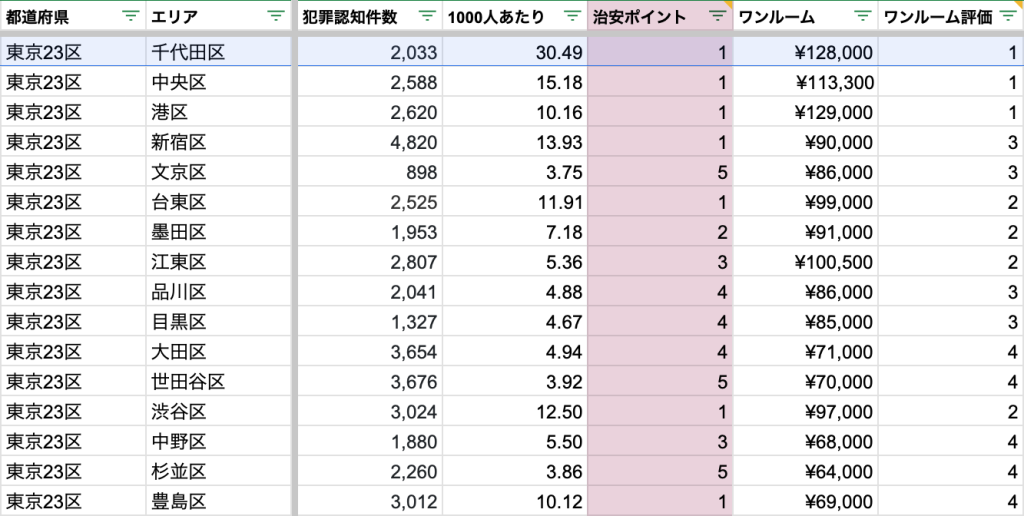
Compared to the surrounding wards, Chiyoda Ward gives the impression of being “bad” in terms of public safety.
The number of crimes in 2022 was 2,033, which is 30.49 crimes per 1,000 people in Chiyoda-ku.
Since the average number of crimes per 1,000 people in other wards is about 6 to 7, Chiyoda Ward was rated as “poor” in terms of public safety.

As mentioned earlier, Chiyoda-ku has an extremely small population compared to other wards. Because of this, the number of crimes per 1,000 people tends to be high, although the number of crimes per 1,000 people is low compared to other wards.
Therefore, although the numerical figures give the impression of poor public safety, the actual situation may not feel that way.
Property quotes in Chiyoda Ward
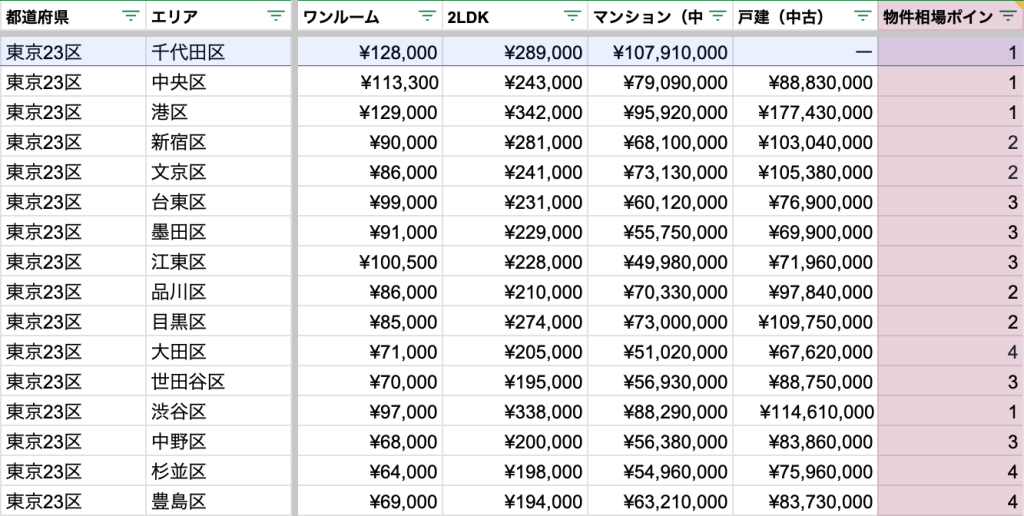
- One room rental = approx. 128,000 yen
- 2LDK rental = approx. 290,000 yen
- Condominiums for sale = approx. 107,000,000 yen
- Detached house = N/A
The market prices of properties for rent and for sale in Chiyoda-ku are shown above.

As shown in the table, compared to other surrounding wards, the property market in Chiyoda-ku was rated higher. Both rentals and sales will require a significant commitment.
Number of Hospitals in Chiyoda-ku

There are 397 hospitals and other medical facilities in Chiyoda Ward.
Calculated on a per 1,000 person basis, the number of hospitals and other medical facilities in Chiyoda Ward is 5.95, which is “more” than the number in our comparison (cities outside the 23 wards of Tokyo that can reach a Yamanote Line station in about 30 minutes).
Chiyoda-ku Childcare
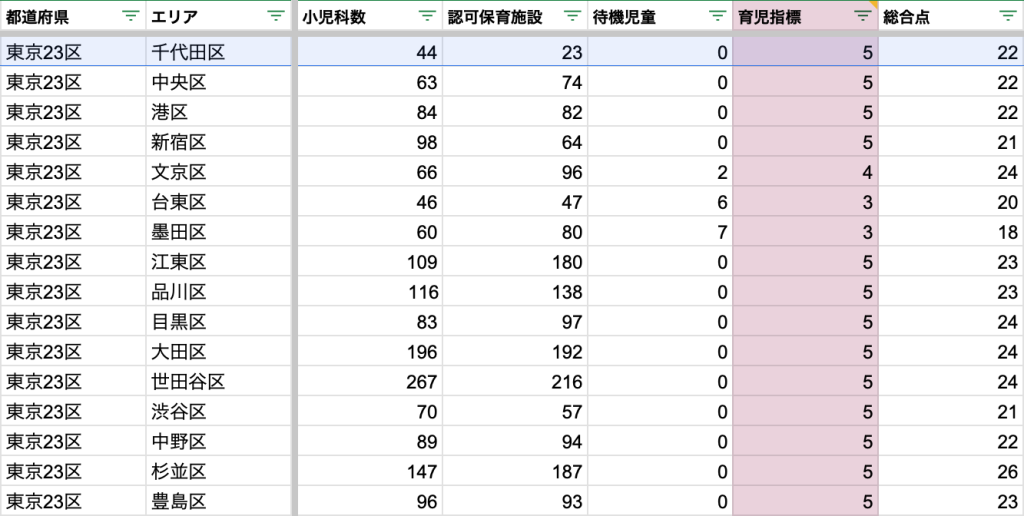
As for childcare, the data for 2022 shows that there were zero children on the waiting list in Chiyoda Ward. In addition, there appear to be 44 pediatricians and 23 licensed childcare facilities.

There are wards within the 23 wards that have waiting lists for children. In contrast, Chiyoda Ward has 0 children, which is a good point for families who want to leave their children with their parents.
“待機児童=Taiki jidō” in Japan refers to children who need but can’t secure a spot in childcare facilities due to shortage. This is a major social issue.
What you need to know before moving to Chiyoda-ku

Here we report on the contents of the regional hazard measurement survey for earthquakes published by the Tokyo Metropolitan Government Bureau of Development.
The above figure is a color-coded diagram of five levels of “overall risk” calculated from “building collapse risk” and “fire risk.
According to the chart, Chiyoda Ward has the lowest risk level from rank 1 (light blue area) to rank 3 (orange area).
The areas in Chiyoda Ward that are particularly high risk (Rank 3) are as follows
- 3 Kandasakumacho, Chiyoda-ku, Tokyo
- 2 Tacho, Chiyoda-ku, Tokyo
- 5 Sotokanda, Chiyoda-ku, Tokyo
For more information, please visit the Chiyoda-ku, Tokyo Metropolitan Government Bureau of Development’s Chiyoda-ku page. If you are considering moving to Chiyoda-ku, we recommend that you take a look at this page.
Chiyoda-ku livability summary
- Tokyo Station, the center of Shinkansen lines extending to all parts of Japan 【Good!】
- Population is expected to increase in the future 【Good!】
- Security is poor 【Bad!】
- High property prices 【Bad!】
- Many hospitals【Good!】
- No children on waiting lists 【Good!】
We checked the livability of Chiyoda-ku and found it to be as shown above.
It is a good point that there are many hospitals and the number of children on waiting lists is zero. On the other hand, it is important to note that the security is poor and the property prices are high.

If you are considering moving to Japan, why not consider Chiyoda-ku as a candidate?
▼Population
https://www.metro.tokyo.lg.jp/tosei/tokyoto/profile/gaiyo/kushichoson.html
▼Future population
https://jmap.jp/cities/detail/city/13101
▼Public order
https://www.keishicho.metro.tokyo.lg.jp/about_mpd/jokyo_tokei/jokyo/ninchikensu.files/R4.csv
▼Market price of property
https://suumo.jp/chintai/soba/tokyo/sc_chiyoda/
https://www.homes.co.jp/mansion/chuko/tokyo/chiyoda-city/price/
https://www.homes.co.jp/kodate/shinchiku/tokyo/23ku/city/price/
▼Taiki jido
https://www.city.chiyoda.lg.jp/koho/kosodate/hoikuen/shien/torikumi.html
▼Number of Hospitals
https://jmap.jp/cities/detail/city/13101
▼Number of approved childcare facilities
https://www.fukushi.metro.tokyo.lg.jp/kiban/fukushi_shisetsu/shs_list/202305.html
▼Tokyo Earthquake Hazard Level
https://www.toshiseibi.metro.tokyo.lg.jp/bosai/chousa_6/1chiyoda.htm
The information published on this site is the data at the time of the survey. Therefore, please be sure to check the latest data by yourself.
